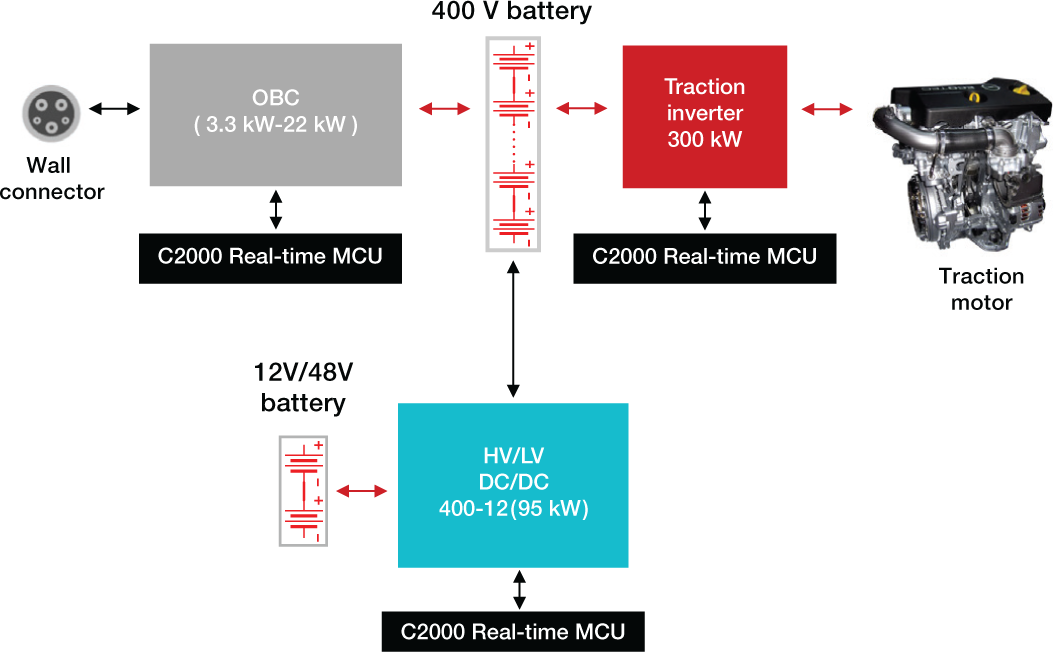SWAY033A december 2020 – december 2020 LMG3410R050 , TMS320F280025 , TMS320F280025-Q1 , TMS320F280049 , TMS320F280049-Q1 , TMS320F28377D , TMS320F28377D-Q1 , TMS320F28377S , TMS320F28377S-Q1 , TMS320F28384D-Q1 , TMS320F28384S-Q1 , TMS320F28386D-Q1 , TMS320F28386S-Q1 , TMS320F28388D , TMS320F28P650DH , TMS320F28P650DK , TMS320F28P650SH , TMS320F28P650SK , TMS320F28P659DH-Q1 , TMS320F28P659DK-Q1 , TMS320F28P659SH-Q1
The electric vehicle (EV) market has been growing rapidly since 2010, with original equipment manufacturers (OEMs) announcing EV models through 2025. This evolution toward more pure EVs rather than hybrids is a reaction to government environmental policies mandating a transition away from internal combustion engines.
Higher-capacity battery packs, while reducing consumer anxiety related to limited driving ranges, place increasing demands on an EV’s power electronics – specifically the onboard charger (OBC), which not only needs to accommodate higher power ratings to accommodate higher power capacities, but must also possess higher power density and higher efficiency to reduce weight of the vehicle and reduce cost per charge.
The emergence of gallium nitride (GaN) and silicon carbide (SiC) wide-bandgap power semiconductors has provided an opportunity to massively shrink the size and weight of the power electronics in EVs given their ability to operate efficiently at much higher switching frequencies than silicon.
The challenge for OEMs and Tier-1s is to provide OBC solutions that can support multiple geographic regions with different power-grid infrastructures. For example, higher power EV chargers in China need to support connections to a three-phase power line, while EVs in the U.S. need to connect to a single-phase power line. OEMs want to supply variants with power ratings ranging from 3.3 kW to 22 kW typically – and as high as 44 kW in some cases.
The most critical systems in an EV powertrain are the OBC that is used to charge the high-voltage battery, the high-voltage to low-voltage DC/DC converter which charges the 12-V/48-V battery, and the traction inverter that controls the EV motor, shown in Figure 1.
 Figure 1 EV Powertrain System Block
Diagram.
Figure 1 EV Powertrain System Block
Diagram.Efficient control and management of the power flow in these systems can be achieved using one or more real-time microcontrollers (MCUs). To save mechanical costs and reduce the size of power electronics, one popular trend is to integrate OBC equipment with the high-voltage to low-voltage DC/DC converter, which can save as much as 10%-20% of board space. However, this adds additional requirements for the real-time MCU, as it need to support more pulse-width modulators (PWMs), more ADCs and allow for multicore processing to manage multiple power stages.
Further, OBCs need to support bidirectional operation for vehicle-to-grid, which result in more complex topology choices that necessitate even greater care when selecting an MCU for an OBC. The MCU must include features that:
- Reduce magnetic size and weight by enabling high frequency operation through high resolution control of power converters duty cycle, frequency, deadband and phase-shift.
- Reduce losses by enabling soft-switching schemes that don’t compromise efficiency, such as critical mode operation and valley switching.
- Reduce cost by increasing analog integration to reduce the number of external components in the design, such as comparators and digital-to-analog converters (DACs).
The MCU should also be part of a scalable portfolio to support the variety of options when integrating OBCs with the high-voltage to low-voltage DC/DC converter. In this white paper, we will review the typical topologies and challenges for each stage and highlight some of the features of C2000 real-time MCUs to help you solve those challenges.